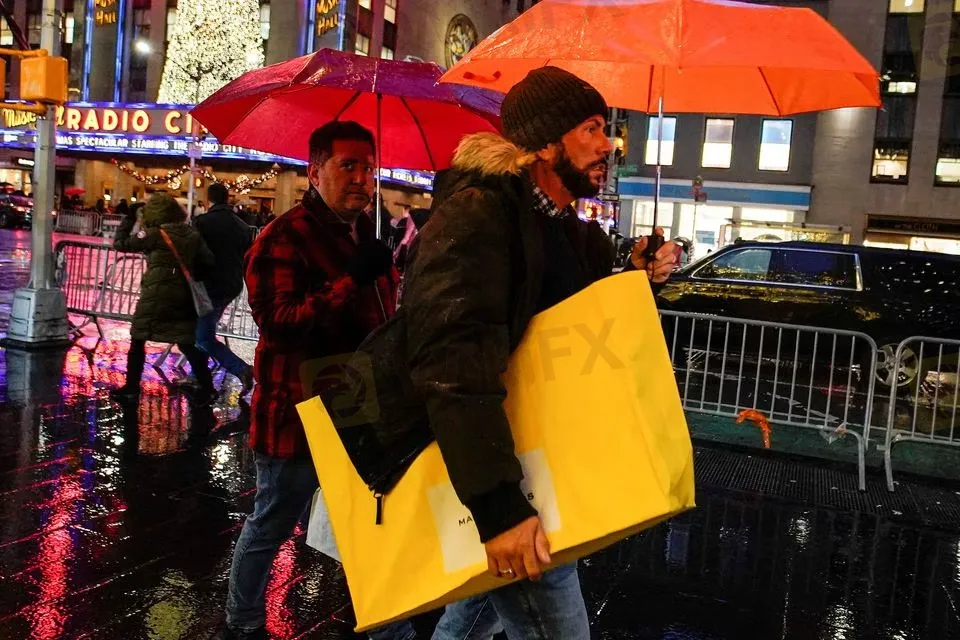简体中文
繁體中文
English
Pусский
日本語
ภาษาไทย
Tiếng Việt
Bahasa Indonesia
Español
हिन्दी
Filippiiniläinen
Français
Deutsch
Português
Türkçe
한국어
العربية
Strong U.S Economic Growth Expected In The Fourth Quarter, Outlook Darkening
Abstract:The U.S. economy likely maintained a strong pace of growth in the fourth quarter as consumers boosted spending on goods, but momentum appears to have slowed considerably towards the end of the year, with higher interest rates eroding demand.

The U.S. economy likely maintained a strong pace of growth in the fourth quarter as consumers boosted spending on goods, but momentum appears to have slowed considerably towards the end of the year, with higher interest rates eroding demand.
The Commerce Department's advanced fourth-quarter gross domestic product report on Thursday could mark the last quarter of solid growth before the lagged effects of the Federal Reserve's fastest monetary policy tightening cycle since the 1980s kick in. Most economists expect a recession by the second half of the year, though mild compared to previous downturns.
Retail sales have weakened sharply over the last two months and manufacturing looks to have joined the housing market in a recession. While the labor market remains strong, business sentiment continues to sour, which could eventually hurt hiring.
“This looks like it could be the last really positive, strong quarterly print we'll see for a while,” said Sam Bullard, a senior economist at Wells Fargo Securities in Charlotte, North Carolina. “Markets and most people will look through this number. More recent data are suggesting that economic momentum is continuing to slow.”
According to a Reuters survey of economists, GDP growth likely increased at a 2.6% annualized rate last quarter after accelerating at a 3.2% pace in the third quarter. Estimates ranged from a 1.1% rate to a 3.7% pace.
Robust second-half growth would erase the 1.1% contraction in the first six months of the year.
Growth for the full year is expected to come in at around 2.1%, down from the 5.9% logged in 2021. The Fed last year raised its policy rate by 425 basis points from near zero to a 4.25%-4.50% range, the highest since late 2007.
Consumer spending, which accounts for more than two-thirds of U.S. economic activity, is expected to have grown at a pace faster than the 2.3% rate notched in the third quarter. That would mostly reflect a surge in goods spending at the start of the quarter.
Spending has been underpinned by labor market resilience as well as excess savings accumulated during the COVID-19 pandemic. But demand for long-lasting manufactured goods, which are mostly bought on credit, has fizzled and some households, especially lower income, have depleted their savings.
Economic growth also likely received a lift from business spending on equipment, intellectual property, and nonresidential structures. But with demand for goods tanking, business spending also lost some luster as the fourth quarter ended.
Despite the clear signs of a weak handover to 2023, some economists are cautiously optimistic that the economy will skirt an outright recession, but rather suffer a rolling downturn, where sectors decline in turn rather than all at once.
ROLLING RECESSION
They argue that monetary policy now acts with a shorter lag than was previously the case because of advances in technology and the U.S. central bank's transparency, which they said resulted in financial markets and the real economy acting in anticipation of rate hikes.
“We will continue to have positive GDP numbers,” said Sung Won Sohn, a finance and economics professor at Loyola Marymount University in Los Angeles. “The reason is sectors are taking turns going down, and not simultaneously declining. The rolling recession began with housing and now we are seeing the next phase which is consumption related.”
Indeed, with demand for goods slumping, factory production has declined sharply for two straight months. Job cuts in the technology industry were also seen as flagging cutbacks in capital spending by businesses.
While residential investment likely suffered its seventh straight quarterly decline, which would be the longest such streak since the collapse of the housing bubble triggered the Great Recession, there are signs the housing market could be stabilizing. Mortgage rates have been trending lower as the Fed slows the pace of its rate hikes.
Inventory accumulation was seen adding to GDP last quarter, but with demand slowing, businesses are likely to focus on reducing stock in their warehouse rather than placing new orders, which would undercut growth in the quarters ahead.
Trade, which accounted for the bulk of GDP growth in the third quarter, was seen either making a small contribution or subtracting from GDP growth. Strong growth is expected from government spending.
While the labor market thus far has shown remarkable resilience, economists argue that deteriorating business conditions will force companies to slow hiring and lay off workers.
Companies outside the technology industry as well as interest-rate-sensitive sectors like housing and finance are hoarding workers after struggling to find labor during the pandemic.
A separate report from the Labor Department on Thursday is likely to show initial claims for state unemployment benefits rose to a seasonally adjusted 205,000 for the week ended Jan. 21, from 190,000 in the prior week, according to a Reuters survey of economists.
“We expect initial jobless claims will eventually start to turn back up after their recent drop, consistent with an eventual downturn in payrolls and a rise in the unemployment rate,” said Kevin Cummins, chief economist at NatWest Markets in Stamford, Connecticut. “In turn, we expect spending to slow as consumers will be less willing to run down savings in the face of a deteriorating labor market.”

Disclaimer:
The views in this article only represent the author's personal views, and do not constitute investment advice on this platform. This platform does not guarantee the accuracy, completeness and timeliness of the information in the article, and will not be liable for any loss caused by the use of or reliance on the information in the article.
Read more

Grand Capital Doesn’t Feel GRAND for Traders with Withdrawal Denials & Long Processing Times
The trading environment does not seem that rosy for traders at Grand Capital, a Seychelles-based forex broker. Traders’ requests for withdrawals are alleged to be in the review process for months, making them frustrated and helpless. Despite meeting the guidelines, traders find it hard to withdraw funds, as suggested by their complaints online. What’s also troubling traders are long processing times concerning Grand Capital withdrawals. In this Grand Capital review segment, we have shared some complaints for you to look at. Read on!

EmiraX Markets Withdrawal Issues Exposed
EmiraX Markets Review reveals unregulated status, fake license claims, and withdrawal issues. Stay safe and avoid this broker.

ADSS Review: Traders Say NO to Trading B’coz of Withdrawal Blocks, Account Freeze & Trade Issues
Does ADSS give you plenty of excuses to deny you access to withdrawals? Is your withdrawal request pending for months or years? Do you witness account freezes from the United Arab Emirates-based forex broker? Do you struggle to open and close your forex positions on the ADSS app? Does the customer support service fail to respond to your trading queries? All these issues have become a rage online. In this ADSS Broker review article, we have highlighted actual trader wordings on these issues. Keep reading!

INGOT Brokers Regulation 2025: ASIC vs Offshore License - What Traders Must Know
Explore INGOT Brokers regulation in 2025: Compare their ASIC and Seychelles FSA licenses, understand trader protection levels, and learn about potential risks in this detailed guide.
WikiFX Broker
Latest News
Consob Targets Political Deepfake “Clone Sites” and Unlicensed Platforms in Latest Enforcement Round
WikiEXPO Global Expert Interviews: Gustavo Antonio Montero: ESG in Finance
Global Guide to Finding Forex IBs/Brokers — Share Your Pick and Win Big!
Trump tariffs are helping drive U.S. beef prices to new highs
Mitrade Arabic Platform Targets MENA Gold Trading Boom
Israeli Arrested in Rome Over €50M Forex Scam
Scam Alert: GINKGO-my.com is Draining Millions from Malaysians!
New FCA Consumer Alert 2025: Important Warning for All Consumers
EmiraX Markets Withdrawal Issues Exposed
Ghost Global Limited (ghostgloballtd.com ) Review: Users Complain About Slow Replies, Fake Portfolio
Currency Calculator



